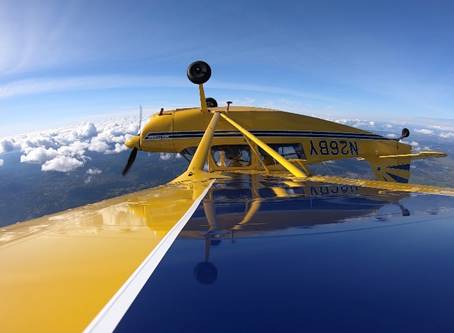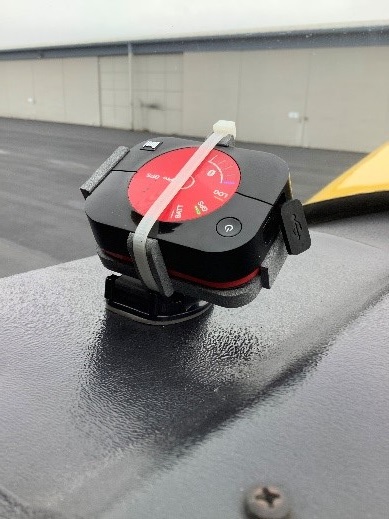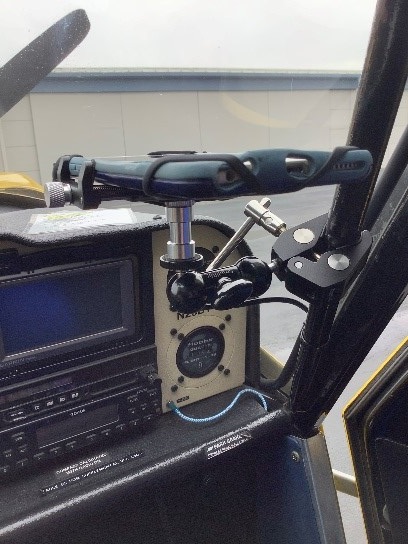by Bruce Mamont, IAC 432407

In 2018 I attended a regional contest on the cusp of cancellation, or so it seemed to novice-me, because we might not have enough judges. Fortunately, qualified non-flying volunteers from neighboring chapters arrived, restoring the contest director’s blood pressure to a normal (maybe even heathy) level. It made me wonder how we might grow more judges; I posted this question on the acro “exploder”.
One surprising response suggested reducing the dependence of contests on judges. The poster asserted that, reminiscent of the “Six Million Dollar Man”, we had the technology. We could record flight track and attitude data that judges subjectively assess for scoring. The data could be quickly post-processed after a flight by a program that would apply IAC scoring rules. “Off the shelf” components were available and affordable. Huzzah! Glass thrown into fireplace.
It seemed to me that replacing judges with ‘bots might be a stretch, but having a tool that coaches, instructors, and pilots could use for training might be valuable. Having experience with integration of new and legacy avionics systems and access to software nerds, I thought developing a prototype would be a fun project. I had in mind something like the “do it yourself” Stratux ADS-B In receivers popular at the time. I had no ambition to come up with a marketable product. My objective was to have fun developing a tool that I could use to practice more productively.
I recruited my favorite nerd and we set out. While not a pilot, he was sufficiently enthused to make the four-hour drive to the next regional contest to learn about pilots, acro, contests, scoring, and our micro-culture.
We developed a design strategy. We’d create a “fast prototype” by adapting a DIY Stratux unit (or an “off the shelf” ADS-B unit like a Stratus). They generate downloadable WAAS GPS flight track data. I owned a Stratux to which we could upload software modifications (a Stratus…not so much). We needed attitude and heading reference system data. It wasn’t clear to me if AHRS capability in units like a Stratus would be good enough. I needed to learn more about requirements for an inertial measurement unit (IMU) module that we could interface with the Stratux. We wanted one that would be affordable and had the performance to provide data at a rate and precision that could support IAC scoring. We sought help on IMU requirements for our prospective application.
I also thought it would be extra cool if our prototype could export data that could be imported into a flight simulation like X-Plane, offering a flight visualization “play back” from a judge’s perspective.
I asked for advice from companies that sold IMUs for aviation. My research discovered efforts like ours, but not specifically for recreational and contest aerobatics.
We received a response from CloudAhoy (https://www.cloudahoy.com/index.php).
CloudAhoy has been developing and marketing a flight debriefing tool since 2011. CloudAhoy caught the interest of the U.S. Air Force for post-flight debriefing of the aerobatic figures performed in the T-6 Texan II. CloudAhoy is much farther along with their capability that my hobby-shop nerds and I could achieve part-time and unfunded. Offered the opportunity to become a volunteer (uncompensated) “beta tester”, we suspended work on our home-grown solution. I signed a non-disclosure agreement and subscribed to CloudAhoy so that I could provide feedback and data from practice flights in our Super Decathlon.
CloudAhoy provides an online visualization and analysis capability that uses data captured during flight. You can check out this “debrief” capability on their YouTube videos. https://www.youtube.com/watch?v=ZugkcepiXu4. They mention their work with the Air Force at about minute 35:26.
A prototype app called FlightTrail captures aerobatic flight data for post-flight viewing in CloudAhoy.
The FlightTrail “beta” is loaded on my iPhone 6 along with the CloudAhoy app. FlightTrail integrates IMU data from my iPhone (who knew?) with data from an external aviation WAAS GPS (not the iPhone GPS). I use a Dual XPS160 that interfaces with my iPhone over Bluetooth. Other aviation WAAS GPS receivers are supported; I just happened to have an XGPS160.
Initial flights using an iPhone RAM mount, which wiggled just a little, revealed the need for an absolutely rigid phone mount. The wiggle was detected by the phone’s IMUs and interpreted as sloppy flying by CloudAhoy. Integrating an inexpensive camera mount with an iPhone mount achieved rigidity. I mounted the phone vertically so that I could see the face to verify the interface between the XGPS and phone, launch FlightTrail to start recording, and to sneak a peek at the weather in Foreflight.

I learned a few things during my recent practice flights during rare good VMC days in the middle of Pacific Northwest winter. Playback of acro figures from a flight last week was hilarious. My counter-clockwise (left) slow rolls appeared as rolls to the right. My 180°acro turns to the left were in the correct direction, but the roll was to the right: picture an “outside” left turn at 70° right bank angle. The most interesting figure play-back was my loop. Mine tend to be “el” like (according to my scores at the one camp and contest I attended last summer). In the play-back they were just bizarre: imagine a SuperD rotating counter-clockwise around the lateral axis, the tail spinning around the CG during an “el” shaped flight path.
Consulting with the CloudAhoy folks suggested we had two issues. FlightTrail “calibrates” airplane attitude during a takeoff roll to define level flight attitude. This is problematic for a tailwheel airplane. Mounting my phone vertically so that I could read it was also a problem. The phone probably needed to be parallel with the SuperD’s longitudinal axis, not vertical. Vertical phone orientation compromised calibration and probably defeated CloudAhoy’s attitude interpretation algorithms.
I uploaded an app to my phone that included a “bubble level” [which one?]; my iPhone mount was sufficiently adjustable that I could use the level app to mount it level to the airplane’s longitudinal axis with some precision, retaining rigidity.

I estimated the angle at which the airplane sits on the ground and adjusted the orientation of the phone using the bubble level angle read-out. Within a degree, my phone was parallel with the longitudinal axis. I don’t know if my geometry calculation was my friend in this instance. I had the app to provide electronic angle measurements; maybe that would have been better than math. I decided that I should pitch to zero-lift axis quickly after applying take off power, maintaining that attitude as long as I had runway to support calibration to establish an estimated level flight attitude.
My next flight was much more successful, at least in eliminating the anomalies that we attributed to the iPhone mounting angle. Huzzah! (throwing glass into the fireplace: optional)
I’m still learning how to use the “debrief” features in CloudAhoy. I wish I could collaborate with whoever is using FlightTrail/CloudAhoy for Air Force acro figure feedback. I suspect that flying a fast, heavy, turbine-powered trainer produces very large figures. The IMU/GPS data rates and precision may be fine to debrief a big radius loop that isn’t scored to IAC standards. For SuperD acro a faster data rate and higher precision may be necessary.
Part of the challenge is: me. There might be an interaction between my novice figure flying skills and the XGPS/iPhone IMU/FlightTrail/CloudAhoy configuration’s capabilities and performance. My computer may also be a factor in playback resolution, but I don’t think so. I have a Windows 10 gaming computer with a fast dual CPU, 32 GB RAM, and a good Nvidia video card. The affordability of a “Coach in a Box” system would be compromised if it required a $3K computer for playback. But I doubt that’s the problem.
I think there’s great potential in a “Coach in a Box” system as a coaching, teaching, and practice tool based on the FlightTrail/CloudAhoy system. It might require better hardware to generate higher resolution flight track and attitude data. I’d be happy to spend what I spend on attending camp for an IMU/WAAS GPS if that’s what’s needed. Attending a camp with a FlightTrail/CloudAhoy system would make camp, the practice following camp, and practice after contests more productive.
Please contact me at mamontb@comcast.net if you have any suggestions.

